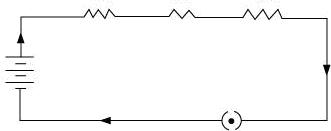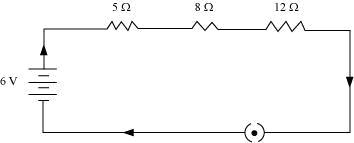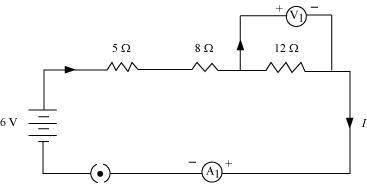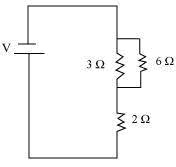Class 10 NCERT Solutions Physics Chapter 11 - Electricity
Electricity Exercise 172
Solution 1
An electric circuit is a continuous conducting path that consists of electric devices, switching devices, source of electricity, etc. connected by conducting wires.
Concept Insight:- The figure given below is an example of an electric circuit.
Solution 2
The unit of electric current is ampere (A).
1 ampere is defined as the flow of 1 coulomb of charge through a wire in 1 second.
Solution 3
One electron possesses a charge of 1.6 × 10 -19 C, i.e., 1.6 × 10 -19 C of charge is contained in 1 electron.
1 C of charge is contained in ![]() electrons
electrons
Therefore, 6.25 x 1018 electrons constitute one coulomb of charge.
Electricity Exercise 174
Solution 1
A source of electricity such as cell, battery, power supply, etc. helps to maintain a potential difference across a conductor.
Solution 2
If 1 J of work is done to move a charge of amount 1 C from one point to another, then it is said that the potential difference between the two points is 1 V.
Solution 3
Concept Insight:- The amount of work done to move to each coulomb of charge is equal to the energy given it.
The amount of work is given by the expression,
Potential difference = 
Work Done = Potential Difference x Charge
Here,
Charge = 1 C
Potential difference = 6 V
Work Done = 6 x 1 = 6J
Therefore, 6 J of energy is given to each coulomb of charge passing through a battery of 6 V.
Electricity Exercise 181
Solution 1
The resistance of a conductor depends upon the following factors:
(a) Material of the conductor, i.e., resistivity of the material.
(b) Temperature of the conductor
(c) Length of the conductor
(d) Cross-sectional area of the conductor
Solution 2
Concept Insight:- Resistance of a wire is given by the relation, ![]()
where,
![]() = Resistivity of the material of the wire
= Resistivity of the material of the wire
l = Length of the wire
A = Area of cross-section of the wire
Resistance is inversely proportional to the area of cross-section of the wire.
Thicker the wire, larger is its area of cross-section and hence lower is the resistance of the wire. Therefore, current can flow more easily through a thick wire than a thin wire.
Solution 3
Concept Insight:- The current flowing through the component is given by Ohm's law.
V = IR
or, I = ![]()
where,
Resistance of the electrical component = R
Potential difference = V
Current = I
The potential difference is reduced to half, keeping the resistance constant.
Let the new amount of current be I '.
Therefore, from Ohm's law, we obtain the amount of new current.

Therefore, the amount of current flowing through the electrical component is reduced by half.
Solution 4
Concept Insight:- Resistivity and melting point are two important factors here.
The resistivity of an alloy is higher than the pure metal. Moreover, at high temperatures, the alloys do not melt readily. Hence, the coils of heating appliances such as electric toasters and electric irons are made of an alloy rather than a pure metal.
Solution 5
(a) Resistivity of iron = 10.0 x 10-8 ohm m
Resistivity of mercury = 94.0 x 10-8 ohm m
Resistivity of mercury is more than that of iron. This implies that iron is a better conductor than mercury.
(b) It can be observed from the table that the resistivity of silver is the lowest among the listed materials. Hence, it is the best conductor.
Concept Insight:- Less resistivity means better conductance.
Electricity Exercise 185
Solution 1
Three cells of potential 2 V each connected in series, is equivalent to a battery of potential 2 V + 2 V + 2 V = 6V. The following circuit diagram shows three resistors of resistances 5 ohm, 8 ohm and 12 ohm respectively connected in series with a battery of potential 6 V and a plug key.
Concept Insight:- The voltages of cells in series add up to give the final voltage.
Concept Insight:- The voltages of cells in series add up to give the final voltage.
Solution 2
To measure the current flowing through the resistors, an ammeter should be connected in the circuit in series with the resistors. To measure the potential difference across the 12 ohm resistor, a voltmeter should be connected in parallel to this resistor, as shown in the following figure.
The resistances are connected in series.
Concept Insight:- Ohm's law can be used to obtain the readings of ammeter and voltmeter.
According to Ohm's law,
V = IR,
where,
Potential difference, V = 6 V
Current flowing through the circuit/resistors = I
Resistance of the circuit, R = 5 + 8 + 12 = 25 ohm
I =  = 0.24 A
= 0.24 A
Potential difference across 12 ohm resistor = VI
Current flowing through the 12 ohm resistor, I = 0.24 A
Therefore, using Ohm's law, we obtain
V1 = IR = 0.24 x 12 = 2.88 V
Therefore, the reading of the ammeter will be 0.24 A.
The reading of the voltmeter will be 2.88 V.
Electricity Exercise 188
Solution 1
(a) When 1 ohm and 106 ohm are connected in parallel:
Concept Insight:- For parallel combination, equivalent resistance R is given by
(1/R) = (1/R1)+ (1/R2)

Therefore, equivalent resistance ≈1 ohm
(b) When 1 ohm, 103 ohm and 106 ohm are connected in parallel:
Concept Insight:- For parallel combination, equivalent resistance R is given by
(1/R) = (1/R1)+ (1/R2) + (1/R3) ……+ (1/Rn)

Therefore, equivalent resistance = 0.999 ohm or 1 ohm
Solution 2
Resistance of electric lamp, R1 = 100 ohm
Resistance of toaster, R2 = 50 ohm
Resistance of water filter, R3 = 500 ohm
Voltage of the source, V = 220 V
These are connected in parallel, as shown in the following figure.
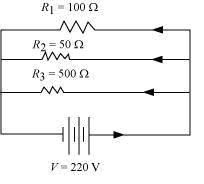
Concept Insight:- For parallel combination, equivalent resistance R is given by
(1/R) = (1/R1)+ (1/R2) + (1/R3)

According to Ohm's law,
V = IR
I = ![]()
where,
I = Current flowing through the circuit

7.04 A of current is drawn by all the three given appliances.
Therefore, current drawn by an electric iron connected to the same voltage source of 220 V = 7.04 A
Let R’ be the resistance of the electric iron. According to Ohm's law,
V = IR' 
Therefore, the resistance of the electric iron is 31.25 Ω and the current flowing through it is 7.04 A.
Therefore, the resistance of the electric iron is 31.25Wand the current flowing through it is 7.04 A.
Solution 3
The advantages of connecting electrical devices in parallel with the battery instead of connecting them in series are:
1. In parallel circuit, if one electrical device stops working, then all other devices keep working normally. This is not the case when devices are connected in series.
2. There is no division of voltage among the appliances when connected in parallel. The potential difference across each appliance is equal to the supplied voltage. In series circuit, the applied voltage is shared by all the appliances.
3. The total effective resistance of the circuit can be reduced by connecting electrical appliances in parallel. In series combination, the total effective resistance of the circuit increases.
Solution 4
There are three resistors of resistances 2 Ω, 3 Ω, and 6 Ω respectively.
(a) The following circuit diagram shows the connection of the three resistors to get a total resistance of 4 Ω.
Concept Insight:- Here, 6 Ω and 3 Ω resistors are connected in parallel.
Therefore, their equivalent resistance will be given by

This equivalent resistor of resistance 2 Ω is connected to a 2 Ω resistor in series.
Therefore, equivalent resistance of the circuit = 2 Ω + 2 Ω = 4 Ω
Hence, the total resistance of the circuit is 4 Ω.
(b) The following circuit diagram shows the connection of the three resistors to get a total resistance of 1 Ω.

Concept Insight:- All the resistors are connected in parallel. Therefore, their equivalent resistance will be given as

Therefore, the total resistance of the circuit is 1 Ω.
Solution 5
There are four coils of resistances 4 ohm, 8 ohm, 12 ohm, and 24 ohm respectively.
(a) Concept Insight:- For getting the highest resistance from a combination of resistances, connect them in series.
If these coils are connected in series, then the equivalent resistance will be the highest, given by the sum 4 + 8 + 12 + 24 = 48 ohm.
Therefore, 48 ohm is the highest total resistance that can be secured by the combination of given resistances.
(b) Concept Insight:- For getting the lowest resistance from a combination of resistances, connect them in parallel.
If these coils are connected in parallel, then the equivalent resistance will be the lowest, given by

Therefore, 2 ohm is the lowest total resistance that can be secured by the combination of given resistances.
Electricity Exercise 190
Solution 1
Concept Insight:- The amount of heat produced in a conductor is proportional to its resistance.
The resistance of the heating element of an electric heater is very high. As current flows through the heating element, it becomes too hot and glows red. On the other hand, the resistance of the cord of the heater is much lower, so it does not become very hot and does not glow when current flows through it.
Solution 2
Concept Insight:- The amount of heat (H) produced is given by the Joule’s law of heating as
H = VIt
where,
Voltage, V = 50 V
Time, t = 1 h = 1 × 60 × 60 s
Amount of current, I =  A
A ![]()
Therefore, the heat generated is 4.8 x 106 J.
Solution 3
Concept Insight:- The amount of heat (H) produced is given by the joule’s law of heating as
H = VIt =I2Rt
where,
Current, I = 5 A
Resistance, R = 20 ohm
Time, t = 30 s
H = 52 x 20 x 30 = 1.5 x 104 J
Therefore, the amount of heat developed in the electric iron is 1.5 x 104J.
Concept Insight:- The amount of heat (H) produced is given by the joule’s law of heating as
H = VIt =I2Rt
where,
Current, I = 5 A
Resistance, R = 20 Ω
Time, t = 30 s
Therefore, the amount of heat developed in the electric iron is
Electricity Exercise 192
Solution 1
The rate of consumption of electric energy in an electric appliance is called electric power. Hence, the rate at which energy is delivered by a current is the power of the appliance.
Concept Insight:- Power of an appliance determines the rate at which electrical energy is delivered to it.
Solution 2
Concept Insight:- Power of an appliance can be determined by the rate at which electrical energy is delivered to it.
Power (P) is given by the expression,
P = VI
where,
Voltage, V = 220 V
Current, I = 5 A
P = 220 × 5 = 1100 W
Energy consumed by the motor = P t
where,
Time, t = 2 h = 2 × 60 × 60 = 7200 s
P = 1100 × 7200 = 7.92 × 106 J
Therefore, power of the motor = 1100 W
Energy consumed by the motor = 7.92 × 106 J
Electricity Exercise Ex. 193
Solution 1
(d) 25
Resistance of a piece of wire is proportional to its length.
The given piece of wire has a resistance R. The wire is cut into five equal parts.
Therefore, resistance of each part= ![]()
All the five parts are connected in parallel. Hence, equivalent resistance (R') is given as
Concept Insight:- For parallel combination, equivalent resistance R' is given by
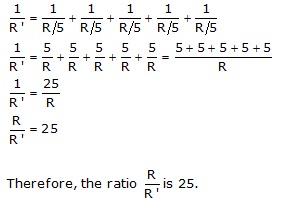
Solution 2
Concept Insight:- Power of an appliance determines the rate at which electrical energy is delivered to it.
Electrical power is given by the expression, P = VI … (i)
According to Ohm's law, V = IR … (ii)
where,
V = Potential difference
I = Current
R = Resistance
So, it can be written that
P = (IR) × I
P = I2 R
From equation (ii), it can be written 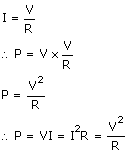
Power P cannot be expressed as IR2.
Solution 3
(d) 25 W
Concept Insight:- Power of an appliance determines the rate at which electrical energy is delivered to it.
Power of an appliance is given by the expression,
P = VI = ![]()
R = ![]()
where,
Power rating, P = 100 W
Voltage, V = 220 V
Resistance, R =  = 484 ohm
= 484 ohm
The resistance of the bulb remains constant if the supply voltage is reduced to 110 V. If the bulb is operated on 110 V, then the energy consumed by it is given by the expression for power as![]()
Therefore, the power consumed will be 25 W.
Solution 4
(c) 1:4
Both the wires have the same resistance because they are made of the same material and have equal lengths and diameters. Let the resistance be R.
For series combination, equivalent resistance Rs is
Rs = R + R = 2R
For parallel combination, equivalent resistance Rp is
![]()
Let the current through the series combination be Is and heat produced in the circuit be Hs.
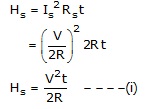
Let the current through the parallel combination be Ip and heat produced in the circuit be Hp.

Therefore, the ratio of heat produced in series and parallel combinations is 1:4.
Solution 5
To measure the potential difference between two points, a voltmeter should be connected in parallel across these points.
Concept Insight:- Voltmeter is always connected in parallel to the element of any electrical circuit across which potential difference is to be measured.
Solution 6
Resistance (R) of the copper wire of length (l) and cross-section (A) is given by the expression,
![]()
where,
Resistivity of copper, ![]()
Area of cross-section of the wire, ![]()
Diameter = 0.5 mm = 0.0005 m
Resistance, R = 10 Ω
We know that,

Therefore, the length of the wire is 122.72 m.
So, if the diameter of the wire is doubled, the new diameter = 2 × 0.0005 = 0.001 m.
Let the new resistance be R'.

Therefore, the new resistance is 2.5 Ω.
Solution 7
The VI graph is shown below. The voltage is plotted on x -axis and current is plotted on y -axis.
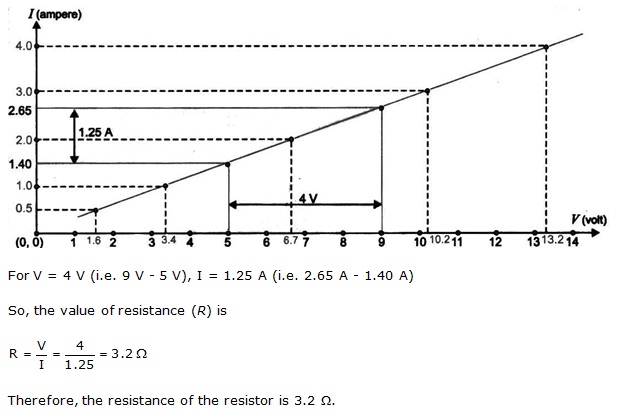
Solution 8
Resistance (R) of a resistor is given by Ohm's law as,
V = IR
R = ![]()
where,
Potential difference, V = 12 V
Current in the circuit, I = 2.5 mA = 2.5 x 10-3 A
Concept Insight: - Convert all the quantities in the same unit system and then proceed to calculations. 
Solution 9
Concept Insight:- In a series combination, current flowing through all the components of the circuit is the same.
There is no current division occurring in a series circuit. Current flow through all the components is the same, given by Ohm's law as
V = IR
where,
V = Potential difference
I = Current through the circuit
R = Resistance of the circuit
Let, R be the equivalent resistance of resistances 0.2 ohm, 0.3 ohm, 0.4 ohm, 0.5 ohm and 12 ohm.
These are connected in series. Hence, the sum of the resistances will give the value of R.
R = 0.2 + 0.3 + 0.4 + 0.5 + 12 = 13.4 ohm
Potential difference, V = 9 V
Therefore, the current that would flow through the circuit and hence 12 ohm resistor is
I = V/R = 9/13.4 = 0.67 A
Solution 10
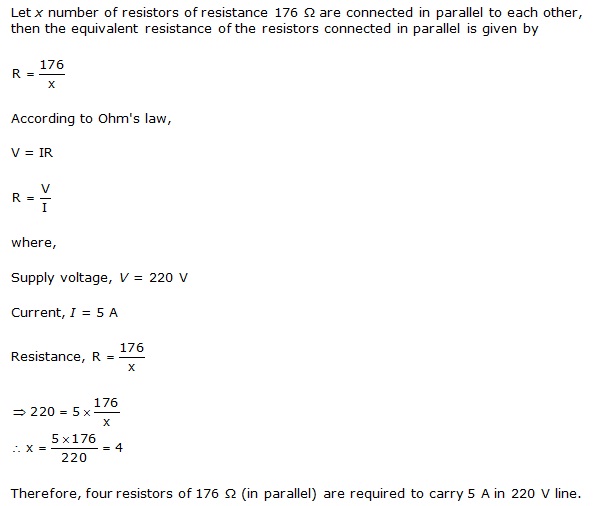
Solution 11
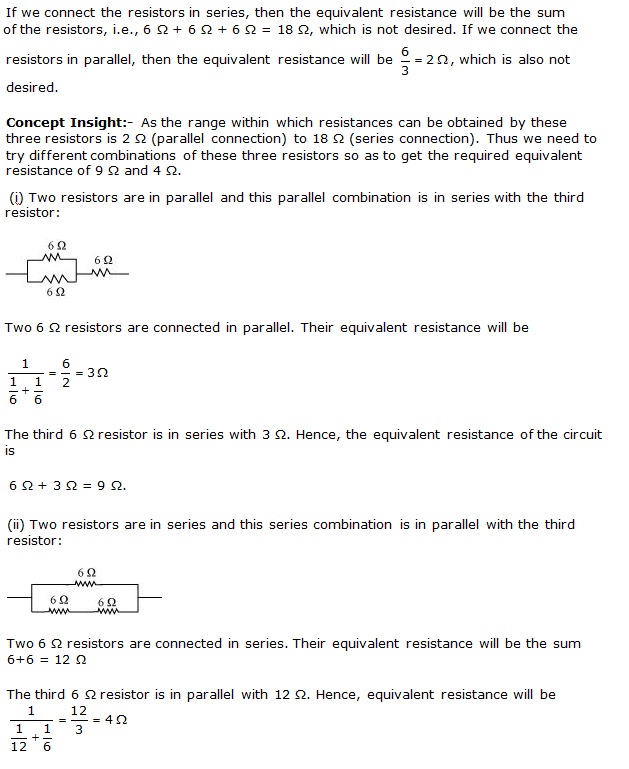
Solution 12
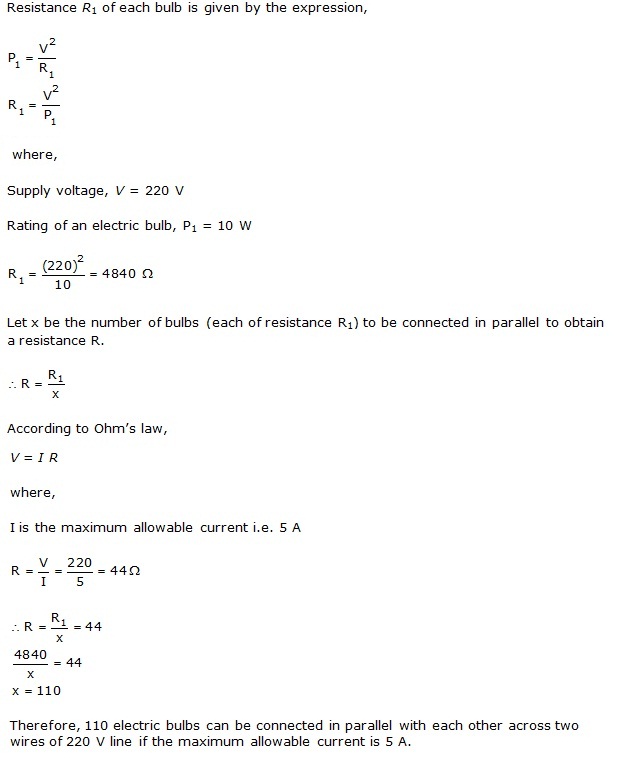
Solution 13
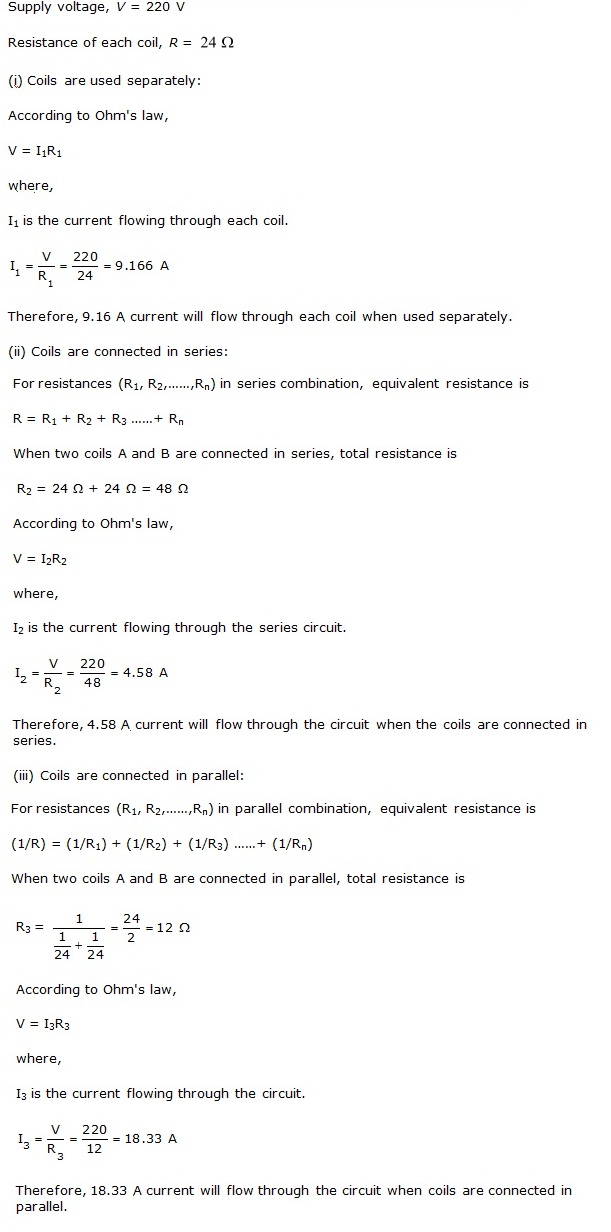
Solution 14

Electricity Exercise Ex. 194
Solution 15
Concept Insight:- The voltage across each component of a parallel circuit remains the same.
Both the bulbs are connected in parallel. Therefore, potential difference across each of them will be 220 V, because no division of voltage occurs in a parallel circuit.
We know, Power = Voltage x Current
Current drawn by the bulb of rating 100 W is given by,
Current = 
Similarly, current drawn by the bulb of rating 100 W is given by,
Current = 
Hence, current drawn from the line = 
Solution 16
Concept Insight: Energy consumed by an electrical appliance is given by the expression,
H = Pt
where,
P = Power of the appliance
T = Time
Energy consumed by a TV set of power 250 W in 1 h = 250 x 3600 = 9 x 105 J
Energy consumed by a toaster of power 1200 W in 10 minutes = 1200 x 600 = 7.2 x 10 5 J
Therefore, the energy consumed by a 250 W TV set in 1 h is more than the energy consumed by a toaster of power 1200 W in 10 minutes.
Solution 17
Concept Insight:- Rate of heat produced by a device is given by the expression for power as
P = I2R
Resistance of the electric heater, R = 8 ohm
Current drawn, I = 15 A
P = (15)2 × 8 = 1800 J/s
Therefore, heat is produced by the heater at the rate of 1800 J/s.
Solution 18
(a) The melting point of tungsten is very high, so the tungsten filament can be kept white-hot without melting away. Hence, tungsten is mainly used almost exclusively for filament of incandescent lamps.
(b) The conductors of electric heating devices such as bread toasters and electric irons are made of alloy because resistivity of an alloy is generally more than that of pure metals of which it is made. It produces large amount of heat. Moreover, at high temperatures, the alloys do not melt readily.
(c) In a series arrangement, if any one of the appliances fails or is switched off, then the flow of current through the entire circuit stops and all other appliances stop working. Thus series arrangement is not used for domestic circuits.
(d) Resistance (R) of a wire is inversely proportional to its area of cross-section (A), i.e.,
![]()
(e) Copper and aluminium wires have low resistivity. They are good conductors of electricity. Hence, they are usually employed for electricity transmission.

